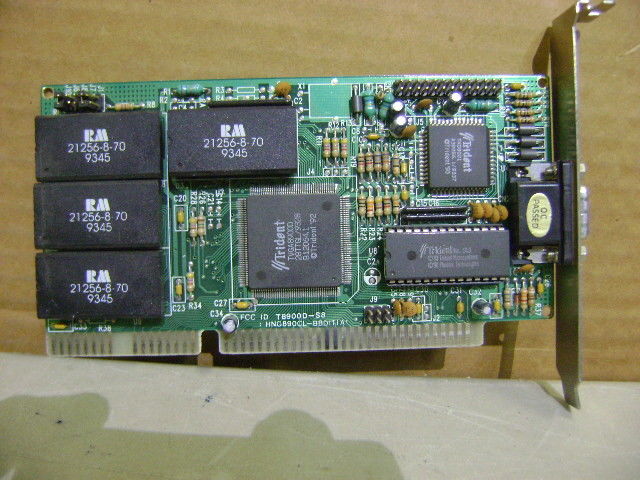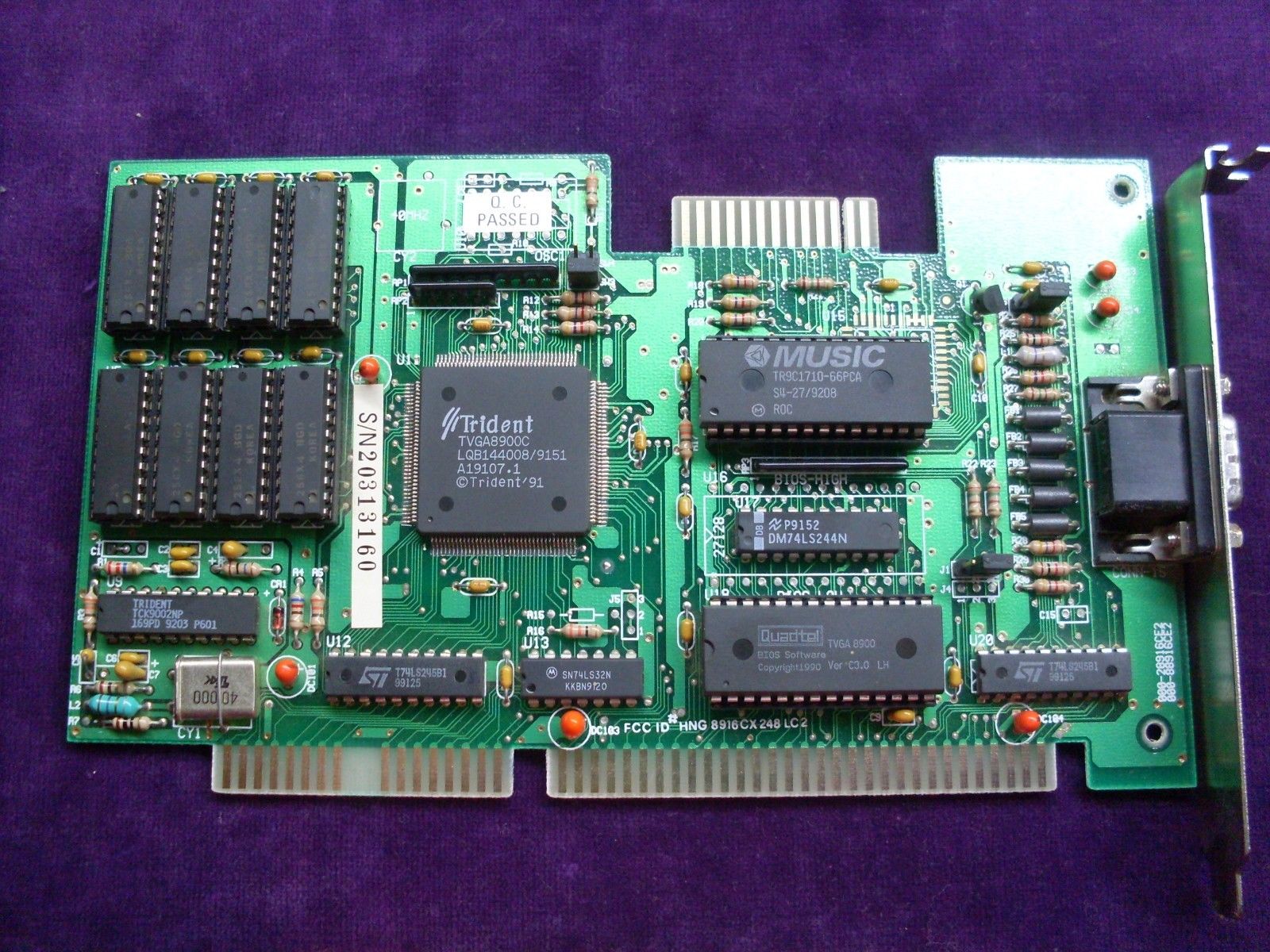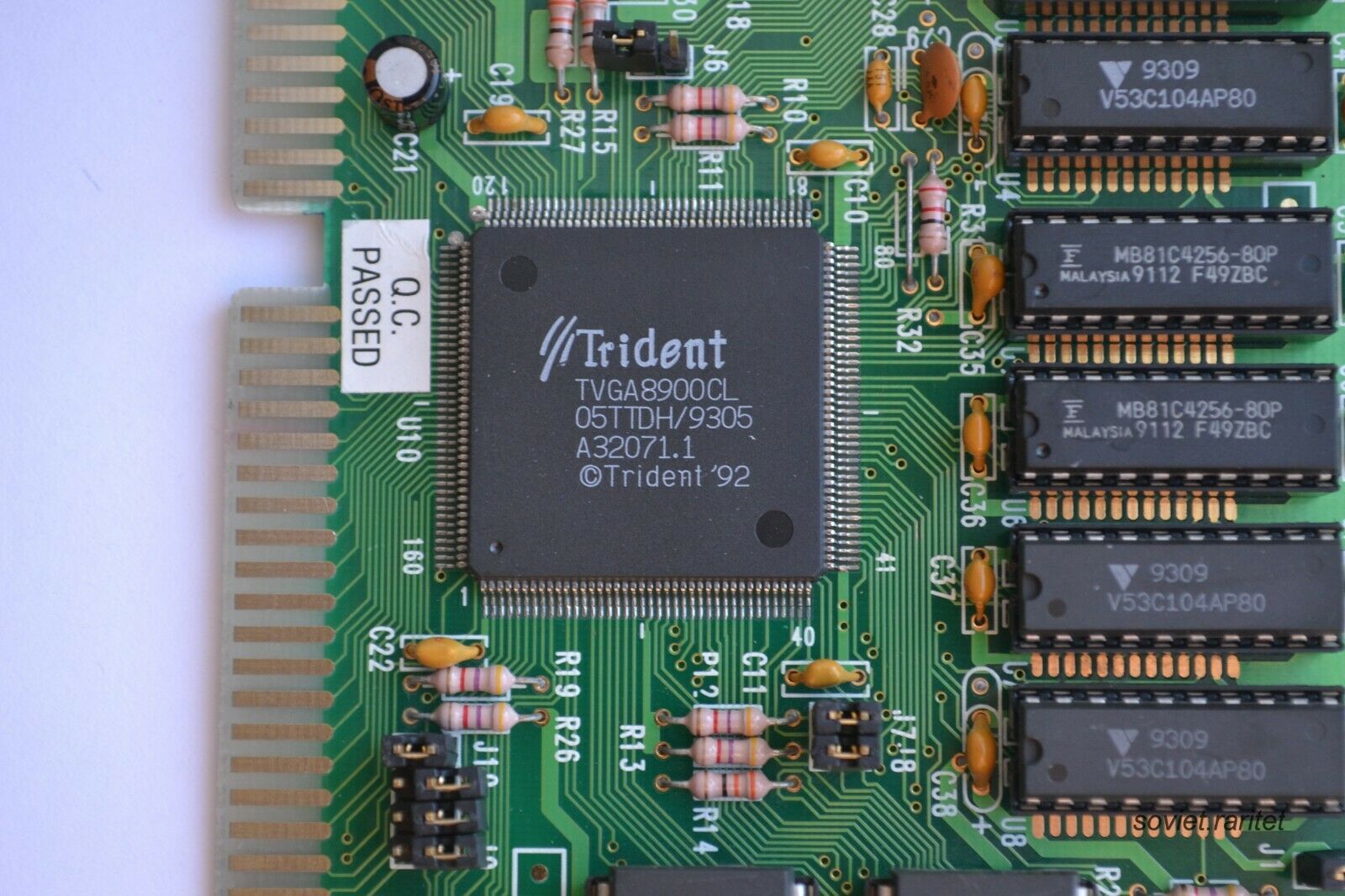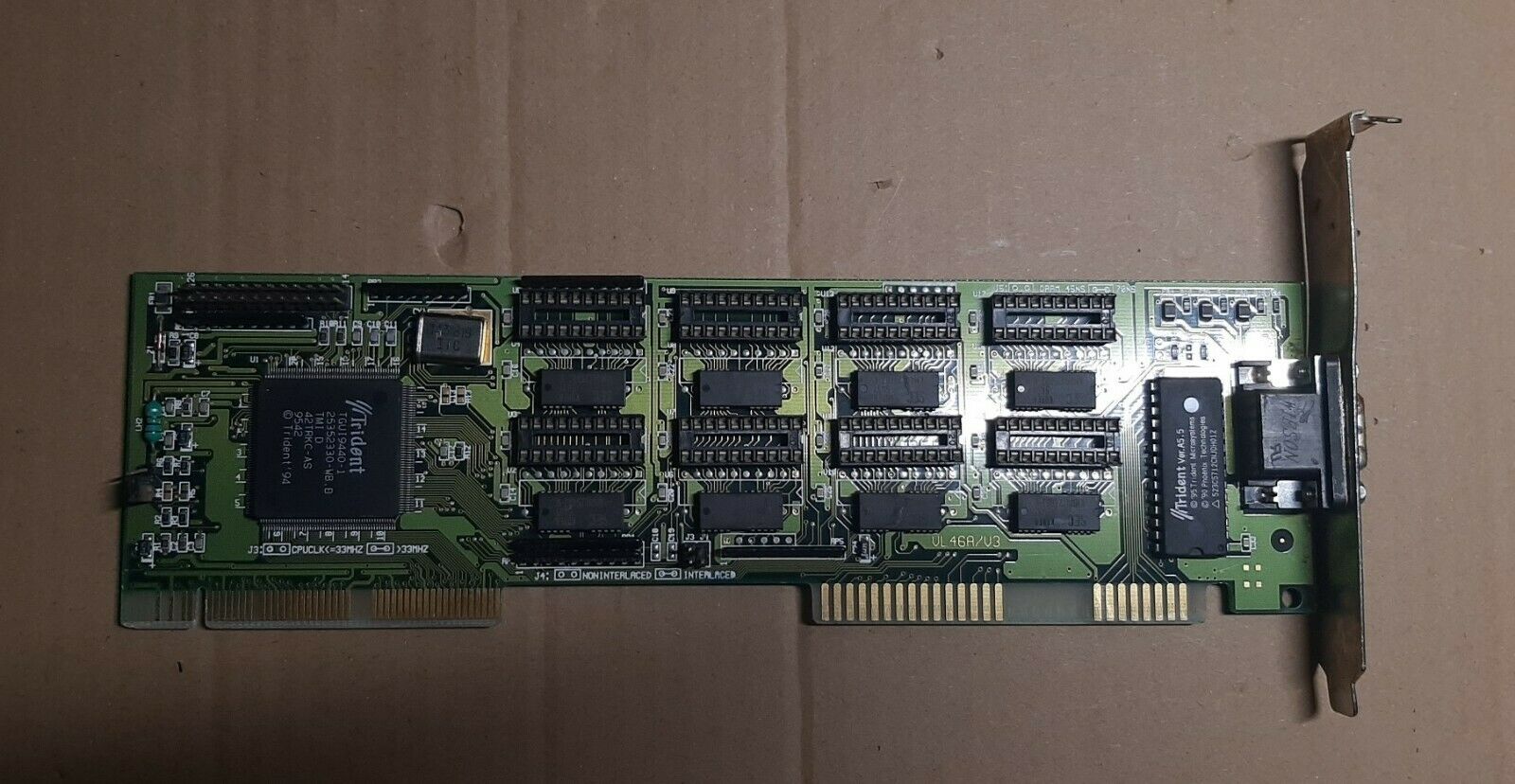Trident was a graphics chipset manufacturer for the IBM PC and its compatibles that started up in 1987. These cards are ubiquitous having been sold to OEMs in large quantities to be installed in their budget-oriented PC clones, and are generally considered to be low performers.
Don't be fooled by the model numbers that Trident uses for its ISA cards. The TVGA8900D is about the fastest chipset they produced for the ISA bus, followed by the 8900C. The 9000 range were designed to be used on budget video cards and for motherboard onboard graphics.
 TVGA-8800C TVGA-8800C
Launched: 1989
Bus: ISA 16-bit
FCC ID: HNG2YPTVGA16
A Hercules/CGA/EGA/VGA and SVGA card.
More Images
  
|
 TVGA-8800CS TVGA-8800CS
Launched: 1990
Bus: ISA 16-bit.
FCC ID: -
A switchable EGA/VGA card.
More Images
 
|
TVGA-8900 (non-C/D)
 Launched: ? Launched: ?
Bus: ISA 16-bit
The first of the 8900 series of VGA chipsets.
|
Impact III
Launched: 1991
Bus: ISA 16-bit
Memory:
Price: $172 (Aug '91)
"PROS: Low cost, widest software support
CONS: Slow performance
The Trident Impact III costs only $12 more on the street than the rock-bottom Boca SuperVGA. Amazingly, for that low $172 price, you get the widest selection of drivers in the roundup.
Trident provides 132-column drivers for Word and WordStar, plus 256-color drivers in all super-VGA resolutions for both Windows and AutoCAD. You don't get a menu for swapping drivers, though, and hardware installation isn't switchless.
The board's speed could be better. In most of the key performance benchmarks, the Impact III hovered in the bottom third.
If you like the idea of 132-column word processing in Word, this board is your best choice. Otherwise, bargain hunters would do better to opt for the superior performance, switchless installation, and even lower price of the Boca SuperVGA."
PC World, August 1991
|
TVGA-8900C / CL / CX2 LC2
 
 Launched: 1991 Launched: 1991
Bus: ISA 16-bit
Memory: 512 KB or 1 MB (FPM 80ns or 100ns)
RAMDAC: MUSIC Semiconductor, Sierra, or Edsun
RAMDAC Speed: 40 or 66 MHz
VESA Standard: Yes, v1.2
FCC ID: HNG8916CX248LC2, HNG890CL-24DI, KBI8900CL4X256
BIOS Dates: 10/25/91 (C3.0), 01/17/92 (C3.01), 09/15/93 (C4.3)
Known BIOS Versions: C3.0, C3.01, C4.01, C4.3(25)
These cards have the common "MUSIC" chip, which is an 8-bit DAC. The card supports up to 70ns DRAMs.
BIOS versions C3.0 and C4.3 are known to be VESA 1.2 compliant. I haven't tested C3.01 or C4.01.
Trident used the 8900C in their own card, the Impact III, which arrived in mid-1991 for a retail price of $295 for the 1 MB version, $229 for the 512 KB, or $195 for the 256 KB version. This card came with a Quantel BIOS and a conventional VGA RAMDAC, though you can optionally buy an Edsun RAMDAC for a further $100 or a Sierra RAMDAC for $50. With 100ns memory the card was forced to run in interlaced mode at 1024 x 768, but with 80ns memory you could run at this resolution in non-interlaced mode. VESA compatibility relied on the loading of a TSR. The card also came with a utility to move the ROM BIOS into RAM (otherwise known as ROM shadowing).
TVGA8900C chipsets can also be found on the following cards:
- Octek MVGA 2000-II
- Trident Microsystems Impact III
- Unknown card with FCC ID: HNG 8916CX248 LC2
- Unknown card with FCC ID: KBI 8900CL4X256
More Images
    
|
TVGA-8900D
 Launched: 199X Launched: 199X
Bus: ISA 16-bit.
Memory: 512 KB
or 1 MB (70ns - 100ns)
FCC ID: HNG890CL-BBD1TIA1
RAMDAC: Trident TKD8001 (24-bit TrueColor)
RAMDAC Speed: 80 MHz
VESA Compatible: Yes, v1.2
FCC ID: HNG890CL-BBD1TIA1 (Rev.E4), KB189D (Rev.B1)
Known BIOS Dates: 12/13/93
Known BIOS Versions: C4.4, C4.5
The Trident TVGA8900D Super VGA Controller was the successor to the TVGA8900CL and TVGA8900C VGA chipset, with the key improvement being faster performance through zero-wait state direct memory writes on the ISA bus and a faster DRAM clock (48 MHz). It also added support for 1 MB of linear memory addressing (no more bank switching). It required just 3 support chips: TKD8001 TrueColor DAC/clock chip and two 256x4 DRAM chips.
Maximum resolution was 1024 x 768 non-interlaced in 256 colours at 72 Hz refresh rate, or 1280 x 1024 interlaced in 16 colours. With the optional TKD8001 TrueColor DAC it was able to run up to 800 x 600 in 64,000 colours.
The TKD8001 TrueColor DAC came in two flavours: a 15/16-bit variant which provided support for 800 x 600 in up to 64,000 colours, or a 24-bit variant which meant 16.7 million colours at 640 x 480 resolution.
Extended text modes included 132 columns x 25, 30, 43 and 60 rows.
TVGA8900D Datasheet
More Images
   
|
 TVGA-9000A TVGA-9000A
Launched: 1991
Bus: ISA 16-bit
Memory: 512 KB (80ns)
RAMDAC: "MUSIC" (8-bit colour depth)
RAMDAC Speed: 66 MHz
VESA Standard: Yes, v1.2
FCC ID: HNG2YPTVGA06X4LS2
BIOS Dates: 05/16/91
Known BIOS Versions: D2.11
An SVGA chipset designed for budget cards. These cards have an 8-bit colour depth DAC. |
 TVGA-9000B TVGA-9000B
Launched: 1991
Bus: ISA 16-bit.
Memory: 512 KB
RAMDAC Speed: unknown
VESA Standard: Yes, v1.2
FCC ID: HNG2VPTVGA06x4LT2, HNG2YPTVGA06X4LT2
BIOS Dates: 11/12/91
Known BIOS Versions: D3.0
An SVGA chipset designed for budget cards. These cards have an 8-bit DAC and support up to 70ns DRAMs. |
 TVGA-9000C TVGA-9000C
Launched: ?
Bus: ISA 16-bit
Memory: 512 KB maximum
FCC ID: HNG900C-BBD5TITA1
Known Board Revisions: H2
The TVGA-9000C was a VGA controller chipset marketed for the lost-cost market. It was the successor to the 9000B. Like the 8900D, the 9000C required just 4 support chips: TKD8001 DAC/clock chip, two 256x4 DRAM chips and the BIOS chip.
With programmable DRAM timings a video card manufacturer could opt for slower and cheaper 100ns memory or faster 70 or 80ns memory.
The 9000C supported a resolution of up to 1024 x 768 in 16 colours - this was non-interlaced if 80ns memory was used or interlaced if 100ns memory was used.
Different TKD8001 DAC variants could be added to the 9000C: a 6-bit variant which permitted up to 800 x 600 interlaced or non-interlaced in 256 colours, and an 8-bit variant that gave the same resolution but in 16.7 million colours.
Extended text modes included 132 columns x 25, 30, 43 and 60 rows.
TVGA9000C Datasheet |
TVGA-9000i ("Surf")
 Launched: ? Launched: ?
Bus: ISA 16-bit or Micro Channel
Memory: 512 KB
(70ns)
RAMDAC: integrated
RAMDAC Speed: 80 MHz
VESA Standard: Yes, v1.2
FCC ID: HNG2VPTVGA06x4LT2
BIOS Dates: 11/12/91, 10/18/93
Known BIOS Versions: D3.0, D4.01E
The Trident TVGA-9000i was a more integrated version of the TVGA-9000C, with the DAC and clock also integrated into the single chip. It was designed to be put directly onto motherboards or low-cost video cards.
The programmable internal clock could be run at up to 80 MHz. The embedded DAC is the 6-bit variant, supporting up to 800 x 600 interlaced or non-interlaced in 256 colours.
Aside from that the TVGA9000i has the same specifications as the 8900C.
TVGA9000i Datasheet
In 2017, Sergey Kiselev reproduced a number of 8-bit ISA SVGA cards around the Trident 9000i chipset. These sold for around £60. You can see images of this here:
    
|
 TGUI9440 TGUI9440
Launched: 1995
Bus: 16-bit ISA, PCI or VLB
RAMDAC Clock: 108 MHz
Memory Clock: 80 MHz
Memory: 512 KB FPM or EDO (expandable to 2 MB)
The TGUI9440 is a "GUI Accelerator", supporting FPM or EDO DRAM memory from as fast as 45ns down to 80ns on a 64-bit bus. The chip itself has an integrated 24-bit TrueColor DAC.
It supports resolutions up to 1280 x 1024 in 256 colours, 1024 x 768 in 64,000 colours, or 640 x 480 in 16.7 million colours.
Hardware acceleration for the following operations: BitBLT, image and text transfer, line draw, short stroke vector draw, rectangle fills, and polygon fills.
On the VESA Local Bus it runs at 50 MHz while on PCI it runs at 33 MHz, and on ISA it runs at 12 MHz.
Cards that are known to use this chipset are:
- Pine Technology PT-540 (see images below) - FCC ID: HNG94DGIBDS4TPX
- SST-9440 PCI
- VL46A/V3 (unknown FCC ID)
TVGA9440 Datasheet
More Images
   
|
TGUI9680 / TGUI9680-1
   
 Launched: 1995 Launched: 1995
Bus: PCI or VLB
RAMDAC Clock: 135 MHz
Memory Clock: 80 MHz
Memory: 1 MB EDO (expandable to 4 MB)
The TGUI9680 is a "GUI and video accelerator", supporting FPM or EDO DRAM memory from as fast as 45ns down to 80ns on a 64-bit bus. The chip itself has an integrated 24-bit TrueColor DAC
It supports resolutions up to 1280 x 1024 in 256 colours, 1024 x 768 in 64,000 colours, or 800 x 600 in 16.7 million colours.
On the VESA Local Bus it runs at 50 MHz while on PCI it runs at 33 MHz.
The TGUI9680-1 is a low-power version of the TGUI9680, but also adds acceleration for Cinepak, Indeo and MPEG CODEC standards.
The TGUI9680 can be found on the following graphics cards:
TVGA9680 Datasheet |
.jpg) 3DImage 9750 / 3DImage9750 3DImage 9750 / 3DImage9750
Launched: 1998
Bus: AGP 1x
Memory: 2 MB or 4 MB SGRAM (64-bit data path)
RAMDAC Speed: 230 MHz
Price When New: $65
A cost-effective (at the time) AGP graphics card with very limited 3D acceleration capability. It retailed for around half what a standard 3D AGP graphics accelerator would have cost back in 1998. Cards based on this Trident chipset did usually also have a TV-out feature able to display 640 x 480 on a standard television. With the full 4 MB of RAM installed, screen resolutions of up to 1600 x 1200 at 24-bit colour depths were possible with refresh rates from 60 Hz up to 200 Hz.
Anandtech reviewed the card and concluded with this:
"Performance wise, the Trident 9750 does its job, nothing more, nothing less. You get much more than you pay for with this card, however don't expect it to turn heads as you benchmark the board against the competition. Reaching performance no-where near that of the Millennium II or Riva 128 cards, the Trident 9750 is probably best fit as a cheap solution to use with a 3D-only accelerator, such as the Voodoo2."
Anandtech, April 1998
Cards that used the 3DImage9750 chipset include:
- Fastware AG110C
- Fastware AG110G (FCC ID: VGA AG110G)
- Daytona 64T
- TD975J Rev.A
- HK9211 Rev.B2 (TD975A)
- HKG9211 Rev.D2
- UNION TD975A
- Chronos ST-975A Rev.C
Image courtesy of Thiago Perroni.
|
.jpg) Blade 3D 9880 Blade 3D 9880
Launched: 1998?
Bus: AGP 2x / AGP Pro
Memory: 4 MB or 8 MB SGRAM or SDRAM
Memory Speed: 125 MHz
Much better than its forebear, the 9750, but still not a fast card.
Cards that used the Blade 9880 chipset include:
Pictures courtesy of Thiago Perroni.
More Images
.jpg) .jpg)
|
 Trident Microsystems, Inc.
Trident Microsystems, Inc.
































 Launched: 1995
Launched: 1995.jpg)
.jpg)
.jpg)
.jpg)